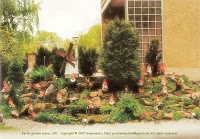Favorite series of reading books remembered
When I was a child, I loved the
Alice and Jerry readers. They were published by Row, Peterson and Company of Evanston, Illinois, and Elmsford, New York .
We didn't use that series in reading class, but we had old copies of the readers on our library shelf and we read them for fun. In particular, I loved
Through the Green Gate,
Friendly Village,
Singing Wheels, and
Engine Whistles. There were
other books in the series, but I remember these four most vividly. I don't think we probably had all of the others; we were just a little one-room country school with a limited budget.
Over the years, I have found two copies of
Singing Wheels and one copy each of
Engine Whistles and
Friendly Village at garage sales and thrift shops. Keely and Isaac read them, and they loved them! I want them each to have their own copies when I am dead and gone, so I may have to break down and buy another
Engine Whistles and
Friendly Village on eBay. I think the price there will probably be more than I paid for the four books I already own because the series is quite collectible.
I guess my kids will get along without
Through the Green Gate. They didn't read it when they were little, so the stories won't be as excited now that they're grown up and jaded. Still, here's what "ImNpieces@aol.com" wrote on
an internet forum about books:
I remember what grade I was in, the 3rd, and the reading book was called "Through the Green Gate," one of the Alice and Jerry books that were used in our schools back then. I loved it so much, that at the end of the school year, I said that I lost the book so I could pay for it and keep it. That was in 1947, and I still have the book. That is the first book that I remember being so attached to that I could not bear the thought of being separated from it.
Modern reading texts are a hodge-podge of stories, poems, plays, and so on, drawn from every culture imaginable. The Alice and Jerry books taught children to read through interesting stories about American children in authentic, historic settings. In the four Alice and Jerry readers I know best, each chapter in the book continues the story from previous chapters. The books follow a group of children through a year (or thereabouts) of their life.
Mabel O'Donnell, author of the series, was an elementary supervisor in Aurora, Illinois (according to Barbara Peck who posted a
nostalgic article about Singing Wheels at Rootsweb). Ms. O'Donnell's great-nephew, Jim O'Donnell wrote to me that she "loved to read, to write, and to teach." (email, October 14, 2009). A little more infomation about her is included in the comments of an article about
the art in Through the Green Gate.
In the two books,
Singing Wheels and
Engine Whistles, the main character was named Tom Hastings.
Singing Wheels was about the first Tom who lived in a log house. In addition to the colored illustrations, many of the pages had black and white drawings of tools, utensils, etc. used in pioneer life. Each story was about some different activity--butchering, cutting ice, spelldowns at school, and so on.
In
Engine Whistles, the first Tom had grown up, married, and now had a son named Tom Hastings who was the new main character. The setting was a small town in the days of steam engines and early automobiles -- perhaps about 1900. I liked that book a lot, but not as well as I liked
Singing Wheels.
I am sure that today these books would be considered culturally biased. They're about people with white skin, except for a few stories that have Indians (now, a politically incorrect term) in them. I didn't think about the racial mix of the characters when I was a child. I just enjoyed the wonderful stories.
Updated June 9, 2010. If you happen to find dead links in this article, please let me know. Thanks!





 Several years ago, I gave a winning eBay bid of about $100 for a new 9x13', 2-room, Coleman Forester tent. It's been a great tent. It's spacious , it has enough headroom that I can stand (always a handy feature in a tent) and it has never leaked even while tents around us became wading pools.
Several years ago, I gave a winning eBay bid of about $100 for a new 9x13', 2-room, Coleman Forester tent. It's been a great tent. It's spacious , it has enough headroom that I can stand (always a handy feature in a tent) and it has never leaked even while tents around us became wading pools.



